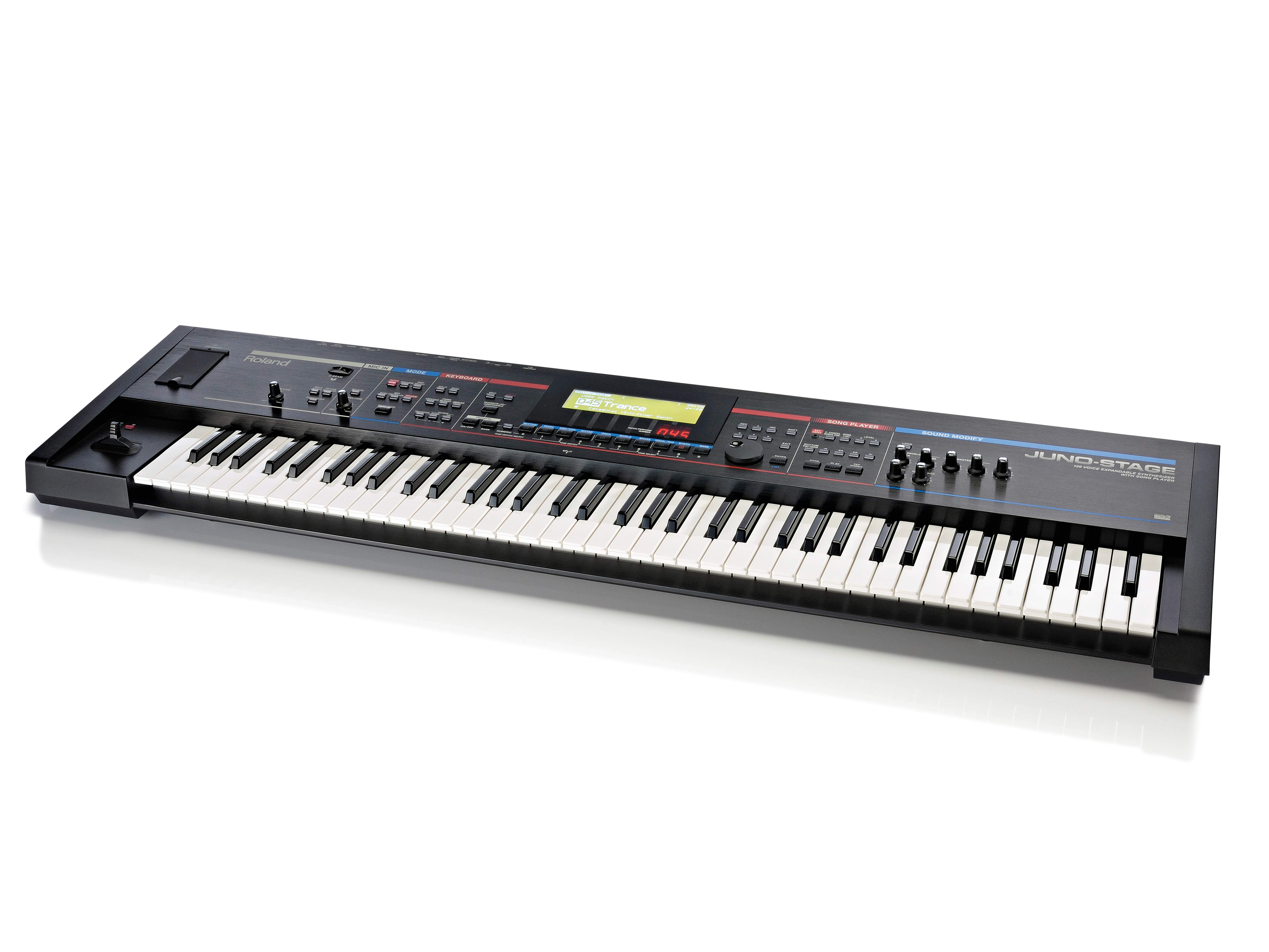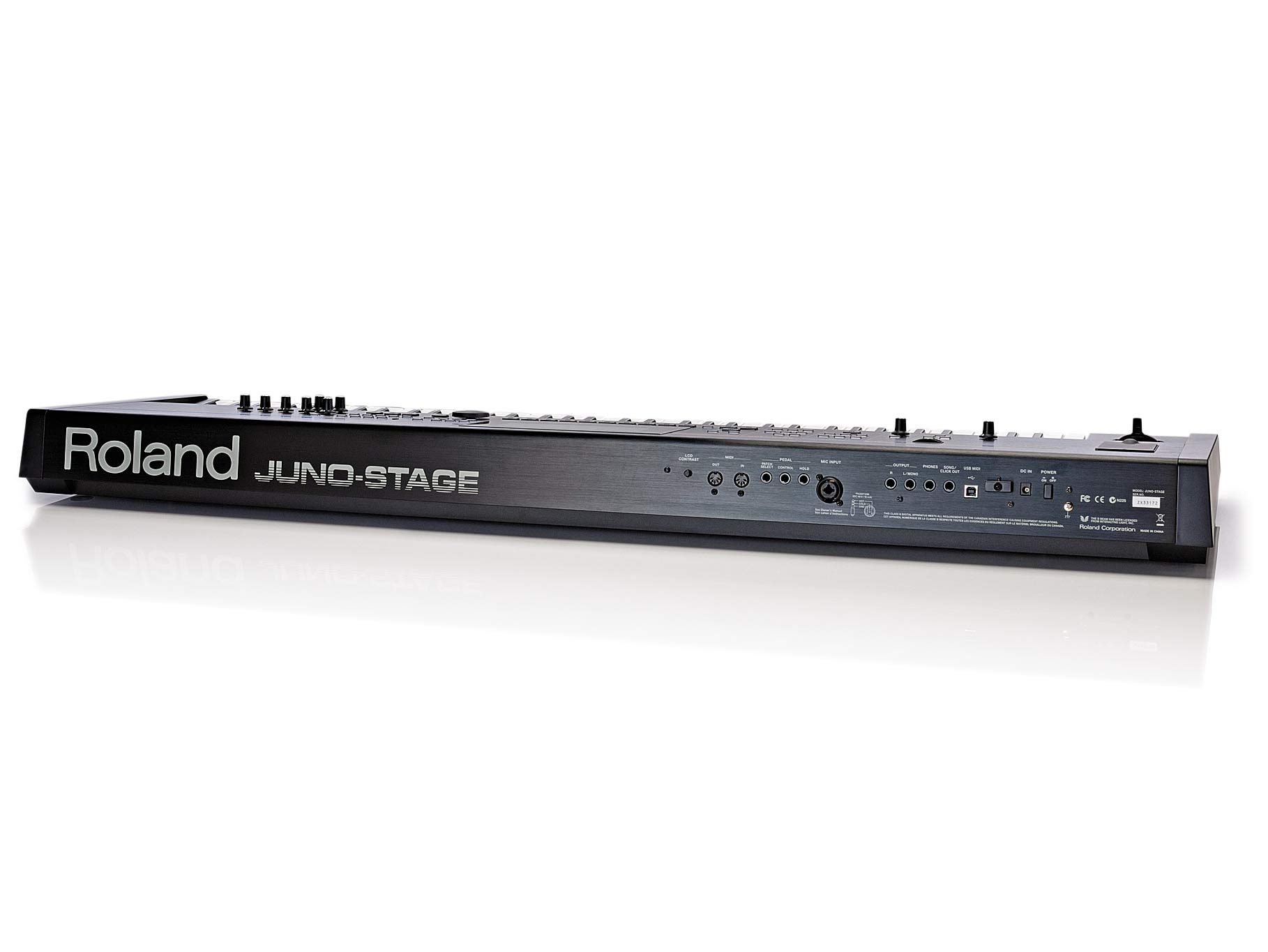MusicRadar Verdict
A very well-specified synth for the money. The Juno Stage sounds great and is easy to use.
Pros
- +
Very portable, sturdy build and decent feeling keyboard. Most main features are easily accessible, though editing can be deep. High-quality, musical and wide ranging sound set is suitable for many styles.
Cons
- -
No weighted keyboard version. No aftertouch.
MusicRadar's got your back

Roland Juno Stage

Roland Juno Stage
Back in 2005 the Juno brand was resurrected with the launch of the Juno-D sample playback synth. While many were disappointed that the new Junos were not analogue synths (as before), they've still proven to be very popular.
The Juno Stage continues down the sample playback route, but this time puts the focus on live performance.
Overview
This is a neat looking synth. It feels very well-made yet it's very light at only 9.8kg (21lbs approx). The switches all feel positive and the dials are responsive and sturdy enough to take plenty of on- and off-stage abuse.
A quick overview of the front panel shows up a few intriguing features. The first (on the far left) is a metal flap concealing a USB port for plugging in a USB memory stick for reading and saving sounds/info.
The Juno Stage can read (in real-time from a USB stick) MIDI files, AIFFs, WAVs and MP3s and add them to playlists (using the included DAW playlist editor) for putting live sets of backing tracks together. You can also play your iPod through the Juno and remove vocals, or use the built-in mic input to sing along with dedicated reverb. Very karaoke, but very practical.
The Juno also has a dedicated click output available when playing back Standard MIDI Files. It's good to see the D-beam included - this is great fun both sonically and visually and enables control of many user-definable parameters such as filter cutoff or LFO in true theremin-style.
The Mode area deals with selecting patches. The Patch button enters Patch mode, enabling selection of preset/user sounds via the panel (or footpedals) which can be made up of up to four PCM waves.
The Performance button puts 16 of these sounds into a multitimbral set for external MIDI control. This mode is also used for setting up splits and the dual button enables two patch layers. This is very easy to set up on the go.
Also in this section are buttons for accessing the parts (layers) within a Performance sound, the MIDI controller function menus (the Stage has comprehensive controller functionality) and the Piano mode button that gives instant access to the Juno's piano and EP sounds.]#
There are 1,027 preset sounds plus 256 GM2 sounds onboard, but unfortunately, only 256 user writeable slots, (though additional sounds are available via SRX card expansion). Preset patches can of course be edited and then stored to this user area.
The centre section is dominated by a monochrome display which is generally clear, though in the effects routing mode, it does become a little cluttered and cryptic.
To the left of the display are controls for accessing the deep editing pages, including envelopes for filter, pitch and amp, a MIDI matrix for assigning MIDI control to virtually any parameter, two LFOs, plus a 16-step LFO for evolving sounds and detailed parameter editing for the arpeggiator and drum sound sets/patterns, effects and more. You can also store your favourite patches and banks for direct instant recall using Favourite mode.
Sounds
The onboard sounds in the Juno provide a hugely versatile basic set for just about any style of production. The overall quality is very good, and there really is something for everyone.
Pianos (acoustic and electric) and strings/guitars have always been a strong point for Roland and they don't disappoint here. The acoustic pianos are wonderfully rich and realistic (there's even control over how open the lid is on the grand pianos) and the electric pianos are also very authentic.
There are also some great analogue-style pads, leads and basses, drums, strings, acoustic/electric basses and some outstanding sitars.
It's just a shame that there's currently no weighted keyboard version on the cards or any aftertouch. As synth action keyboards go, though, this is well-balanced, feels high-quality and gives the extra keys that 'serious' players demand at a superb price.
The Sound Modifying section provides instant access to key parameters including filter, amp envelope, 2-band EQ and reverb level. Filter types include three types of low-pass, a peaking filter that's great for wah effects and a high-pass and band-pass.
These all sound smooth and juicy with little stepping, even at high resonance levels. In fact, it's really hard to find fault with this synth sonically.
Effects, vocoding and arpeggiator
The Juno Stage is very well specified in the effects department. Patch mode allows the use of one Master FX processor, one chorus and one reverb, while Performance mode allows three Master FX units, one chorus and one reverb. There are 79 effect types in total, plus a global chorus and reverb processor.
Of the 79 types available, notable effects include the slicer that rhythmically slices a sound into segments using an LFO, the tape delay which sounds very tapey indeed, and a very nice COSM guitar amp simulator. You'll also find some very lush choruses, phasers and various other delays, the great rotary speaker emulation from the Roland VK7 organ, a 16-step sequenced ring modulator, a lo-fi compressor, radio noise emulator and much more.
These are all top-quality, have plenty of user definable parameters and add greatly to any sound routed through. There's also a half decent vocoder that can be used in conjunction with the onboard mic input, though we had trouble getting the sound clear enough to distinguish words clearly. A comprehensive arpeggiator rounds things off nicely.
Summary
All in all, this is a very well-featured and high-quality synth, especially when you consider the price. It provides very good value for money and there's enough onboard to keep anyone occupied for a long time.
The only real downsides are the lack of aftertouch, individual outputs and user writeable memory and the wall-wart power supply.
If you are looking for a £1,000 gigging synth that can suit pretty much any application save for sequencing or sampling, the Juno Stage fits the bill.
Future Music is the number one magazine for today's producers. Packed with technique and technology we'll help you make great new music. All-access artist interviews, in-depth gear reviews, essential production tutorials and much more. Every marvellous monthly edition features reliable reviews of the latest and greatest hardware and software technology and techniques, unparalleled advice, in-depth interviews, sensational free samples and so much more to improve the experience and outcome of your music-making.
“We’re still avoiding him to this day... we would just despise him after a while”: Flaming Lips' Wayne Coyne is not a Billy Corgan fan
“KIKI BOY 2025”: Frank Ocean appears to be teasing something... or other
“This is great. I knew I was getting to them! I’m so happy. It’s such a good feeling”: Spotify bites back at Kate Nash










